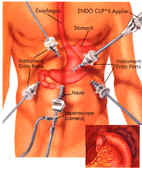 The most common gastro-intestinal peristaltic disorder is oesophageal reflux disease. About. 6% of the population suffers on a regular basis. Nearly half of these patients during endoscopic examinations show signs of oesophageal inflammation.
The most common gastro-intestinal peristaltic disorder is oesophageal reflux disease. About. 6% of the population suffers on a regular basis. Nearly half of these patients during endoscopic examinations show signs of oesophageal inflammation.
Gastro-oesophageal reflux is usually accompanied by heartburn sensation but this may lack fully in many patients. Heartburn is a burning sensation in the centre of the chest that often occurs after eating, bending over, with exercise, and sometimes at night when lying down. Approximately one in 10 adults has heartburn at least once a week and one in three monthly. Some pregnant women experience heartburn almost daily as a result of increased pressure on the abdomen and hormonal changes. Although its name implies otherwise, heartburn has nothing to do with your heart. Rather, these symptoms indicate a condition called gastroesophageal reflux disease, or GERD.
In less severe cases, a reasonable dietary transition or a change in lifestyle habits will be sufficient (several small, protein-rich meals throughout the day, the avoidance of later food intake, weight reduction). Symptomatic Antacids can also be given. In moderately severe cases, the H2-receptor antagonists possibly combined with Prokinetika are indicated. With a consistent drug therapy almost all of the severity of reflux can be treated successfully within three months. A crucial characteristic of the disease, however, is the persistent recurrence tendency in severe cases. A recurrence rate of approximately 90% within the first 200 days must be calculated even after a successful therapy.